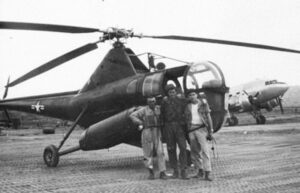4 September 1950 – Cpt Robert E. Wayne becomes the first pilot to be rescued from behind enemy lines by a helicopter.
By June of 1950, Capt. Robert E. Wayne was already a seasoned pilot. While flying an F-80 Shooting Star, he shot down two enemy aircraft on a single mission on the first day of the conflict.
 The following story of Capt. Wayne is from pilotspost.co.za
The following story of Capt. Wayne is from pilotspost.co.za
“In the late afternoon of September 4, 1950 while flying a strafing mission, Capt. Wayne was hit by ground fire. Pulling up to 1,100 feet, he realized that he couldn’t save the burning plane. Badly injured with burns on his leg and both arms, he bailed out and landed in a rice paddy five miles behind enemy lines, just north of Pohang. Even as he landed, enemy infantry were already closing in. There was nowhere to hide. Still, there was hope – the other 13 aircraft of his attack mission were orbiting overhead.”
“It wasn’t long before an H-5 helicopter was airborne out of Pusan, piloted by 1LT Paul W. van Boven. In the back, the assigned paramedic was Corporal John Fuentez. For 1LT van Boven, the choice of whether to go was clear – a former B-17 who had been shot down and taken prisoner during WWII, he had no intention of letting another man experience a POW camp, or worse. Clearly, the situation was desperate and everyone knew with certainty that the North Koreans had no intention of taking the downed airman alive. They were out for revenge.”
“The H-5 was ill-suited for combat rescue – it was unarmoured and unarmed. Between the two men, they had a pistol and a carbine… To avoid enemy ground fire, 1LT van Boven flew east and went offshore before turning north to fly beyond the Pusan Perimeter. Once at a point east of the downed pilot, he descended low to the water and turned toward the shor… Meanwhile, over the radio, he could hear that one by one, the F-51s were leaving, forced to return to base with low fuel. By the time he arrived, just four were left on station – it had been two hours since Capt. Wayne had been shot down. Nightfall was approaching and, if the mission wasn’t accomplished now, there was no way to save the wounded piloted.”
A “downed F-51 Mustang was still visible in that area. He searched but did not see the pilot, but then recognized that the other four F-51s were making strafing passes against enemy forces alongside an adjacent rice paddy. At that moment, he realized that the enemy was that very close. The wounded pilot was hiding in a rice paddy, hoping to avoid enemy fire,…”
“1LT van Boven flew around the paddy and then approached from the north, hoping to surprise the enemy by arriving from an unexpected direction.
Seconds later, Capt. Wayne heard the rotors of the H-5 helicopter nearby – he looked south but saw nothing, then realized the sound was coming from behind him, from the north. He stood and turned and saw the helicopter hovering a distance away. It was now or never. He ripped open his flight suit and peeled off his white undershirt. Waving the shirt frantically, he ran toward the helicopter, in excruciating pain from his burns. From all around, the enemy troops opened fire. They too realized that it was now or never – they opened fire with everything they had. Bullets were soon striking the helicopter, which flew closer and set down on the edge of the rice paddy, ignoring the incoming small arms fire.
Cpl. Fuentez, reached out and grabbed Capt. Wayne as he staggered up to the helicopter. As he pulled the pilot into the H-5, 1LT van Boven pushed the stick forward and headed back toward the coastline as Cpl. Fuentez quickly reported on the damage to the helicopter – there were a lot of holes, but nothing critical had been hit.”
